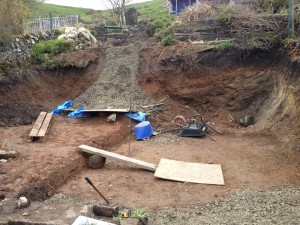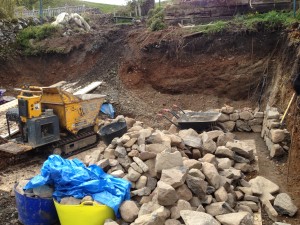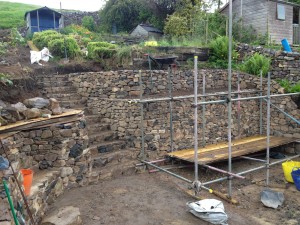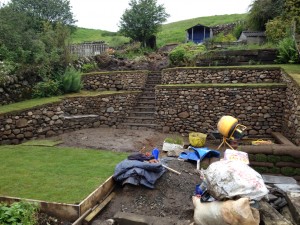Before, during and after
I usually take lots of pictures when I am working to record how the job is progressing. Usually I just post them to my Stone Inspired Facebook page to keep my followers updated with what I am building.
After looking through the pictures I had taken of my recent job in Carlops, I thought it would be good to post a rough sequence of photos illustrating the progress of a big job.
The retaining wall and steps in Carlops took a total of 16 1/2 man days of dry stone walling time; and 11 days of a labourers time. The client had employed the services of a construction company to remove tens of tonnes of soil in this sloped garden in order to create the space for the steps and retaining wall. The ground was prepared before we started building – we “just” had to move the stone down so that we could begin building.
We then brought in more than 40 tonnes of stone, 3 1/2 tonnes of sand, 7 tonnes of hardcore and 20 bags of cement. Thankfully we were able to construct a ramp and bring in the stone using a tracked dumper. It was hard work moving all of this material, particularly as it rained a lot of the time, making the dumper hard to handle. Once the lower retaining wall was built to its completed height of 2.2m, we put up scaffolding to build the top tier. 12 steps were built just off-centre and a bench was added to the left side of the garden. The very far right retaining wall was mortared as the space to build was too narrow for a properly constructed dry stone wall – sometimes you have to “cheat” a little! Once all of the stone work was built, we laid 100m2 of turf to complete the work.
All in all a nice job (apart from the rain and the midges!)



![IMG_0504[1] A dry stone walling job - in progress](http://www.stoneinspired.com/wordpress/wp-content/uploads/2012/07/IMG_05041-300x225.jpg)


well done. complicated geology aroundcarlops, you could have used many types of stone and still kept it all local
Most of the stone for this job is a “whinstone” from an old, tumble-down wall near Kelso: the suppliers are based there. Another four tonnes came from a farm in East Lothian – amazingly it was very similar in colour, style and shape. It was all very dense and heavy!
What an incredible job you are all doing! Great pictures Jason !